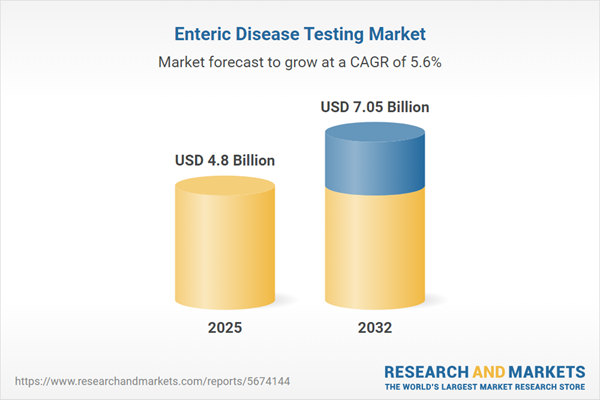Speak directly to the analyst to clarify any post sales queries you may have.
The enteric disease testing market is evolving rapidly as healthcare systems worldwide prioritize swift, accurate diagnostics to address public health challenges. This report offers senior decision-makers a clear view of trends, segmentation, and strategies shaping this critical sector.
Market Snapshot: Enteric Disease Testing Market Size and Growth Outlook
The Enteric Disease Testing Market grew from USD 4.54 billion in 2024 to USD 4.80 billion in 2025. It is expected to continue growing at a CAGR of 5.64%, reaching USD 7.05 billion by 2032.
Scope & Segmentation of the Enteric Disease Testing Market
This market research report comprehensively covers the full value chain, segmenting by test methods, product types, end-users, pathogens, samples, and channels across Americas, Europe, Middle East & Africa, and Asia-Pacific. Technologies tracked range from traditional assays to cutting-edge molecular diagnostics and next-generation sequencing.
- Test Methods: Biochemical tests, culture methods, immunoassays, molecular diagnostics, sequencing
- Product Types: Consumables (kits, reagents), instruments (immuno analyzers, PCR instruments, sequencers), software and services (data analysis, maintenance)
- End Users: Academic and clinical laboratories, diagnostic laboratories, hospitals, research institutes
- Pathogens: Bacterial (Campylobacter, Escherichia coli, Salmonella), viral (adenovirus, norovirus, rotavirus), parasitic
- Sample Types: Blood, rectal swabs, stool
- Distribution Channels: Direct sales, distributors, online sales
- Regions: Americas (including US, Canada, Latin America), Europe, Middle East & Africa (with detailed country analysis), Asia-Pacific (covering major and emerging markets)
- Key Companies: Thermo Fisher Scientific, bioMérieux, Abbott, Roche, QIAGEN, Becton Dickinson, Bio-Rad, Danaher, PerkinElmer, DiaSorin
Key Takeaways for Decision-Makers
- Enhancements in molecular diagnostics, such as real-time PCR and next-generation sequencing, continue to raise standards for sensitivity and speed across both centralized and decentralized testing environments.
- Point-of-care and digital health platforms are reshaping delivery, enabling rapid data integration and decision support in a variety of healthcare settings—even remote areas.
- Supply chain resilience is gaining importance, with manufacturers and providers turning to regional sourcing and diversified supplier relationships.
- Decentralization trends and regulatory updates drive continuous adaptations in procurement, with providers favoring bulk agreements and value-based contracts to manage costs.
- Strategic collaboration among test developers, reagent suppliers, and data analytics firms is facilitating a shift toward high-throughput, fully automated, and interconnected diagnostic workflows.
Tariff Impact: Navigating Policy-Driven Cost Structures
The introduction of new tariffs in the US during 2025 has reshaped cost structures for diagnostic labs and suppliers. Elevated import duties on key reagents and instruments have sparked adjustments in procurement, with some organizations seeking domestic sourcing or tariff-exempt production to buffer expenses. Laboratories and diagnostic providers are also renegotiating service contracts and increasing bulk purchases to contain budget impacts. These shifts underscore the importance of agile procurement and localized manufacturing in sustaining business continuity.
Methodology & Data Sources
Analysis integrates peer-reviewed literature, regulatory reports, company disclosures, and primary interviews with clinical, procurement, and supply chain experts. Both secondary and direct feedback verify key trends and assumptions, using frameworks like SWOT, Porter’s Five Forces, and quantitative data triangulation to ensure reliable, actionable intelligence.
Why This Report Matters: Strategic Value for Leaders
- Informs investment in technology that aligns with evolving healthcare delivery and public health imperatives, supporting both operational efficiency and clinical outcomes.
- Equips stakeholders with clarity on market forces, regulatory shifts, and innovation pathways, empowering informed allocation of R&D and procurement resources.
- Delivers practical recommendations for optimizing diagnostic portfolios, fortifying supply chains, and fostering cross-sector partnerships to drive sustained growth.
Conclusion
This report enables decision-makers to confidently guide enteric disease testing investments amid a shifting landscape. With clear segmentation insights and actionable strategic guidance, organizations are well-positioned to address evolving clinical and public health demands.
Additional Product Information:
- Purchase of this report includes 1 year online access with quarterly updates.
- This report can be updated on request. Please contact our Customer Experience team using the Ask a Question widget on our website.
Table of Contents
3. Executive Summary
4. Market Overview
7. Cumulative Impact of Artificial Intelligence 2025
Companies Mentioned
The companies profiled in this Enteric Disease Testing market report include:- Thermo Fisher Scientific Inc.
- bioMérieux SA
- Abbott Laboratories
- Roche Holding AG
- QIAGEN N.V.
- Becton, Dickinson and Company
- Bio-Rad Laboratories, Inc.
- Danaher Corporation
- PerkinElmer, Inc.
- DiaSorin S.p.A.
Table Information
| Report Attribute | Details |
|---|---|
| No. of Pages | 198 |
| Published | October 2025 |
| Forecast Period | 2025 - 2032 |
| Estimated Market Value ( USD | $ 4.8 Billion |
| Forecasted Market Value ( USD | $ 7.05 Billion |
| Compound Annual Growth Rate | 5.6% |
| Regions Covered | Global |
| No. of Companies Mentioned | 11 |









